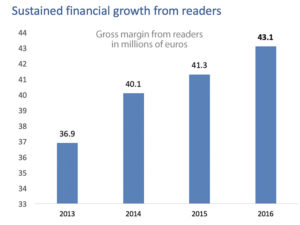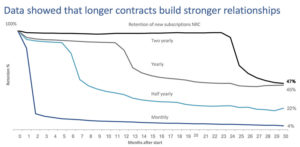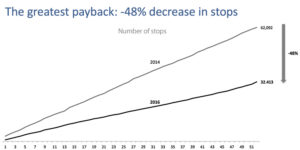By: Xavier van Leeuwe, Matt Lindsay, Matthijs van de Peppel
It is obvious that the use of data can make news organisations thrive. But many publishers and editors need a better vision. They can get trapped in Big Data, wondering, “What do we do with all that information?”
The ultimate goal should be to achieve better customer contact and to build long-term customer relations to be successful financially as a news business. In our book How To Succeed In The Relationship Economy, we explain how to build a data-rich and customer-centric culture, even in small teams, drawing from our experience with over 500 media titles.
As Google and Facebook are getting a larger piece of the advertising pie, newsroom employment continues to fall. With ongoing pressure on advertising revenue expected, news organisations have a great opportunity to rely on a more stable source of income: readers.

With the help of Mather Economics, NRC has reached the point where 82% of our revenue is from readers. Our country is small, with only 7 million households. And we are in a highly competitive print news market with lots of free online competitors (we are a leading country with a 94% Internet penetration). Still, our reader base has been growing year after year.
This happened after a decade of decline in both advertising and readership. Using the steps we describe in our book, we managed to halve the number of subscription stops and more than double the acquisition of new readers.
We applied two fields of knowledge to accomplish this: customer relationship building and quantitative analysis.
Taken separately, the fields of customer experience and customer analytics have much to offer. And they are in high demand in their own rights. When combined, these fields are more than the sum of their parts.
We have seen that using the insights and analytical tools in the book can help news companies succeed in the evolving economy we live in, which we have dubbed the “Relationship Economy.”
The “Relationship Economy” is here
After you woke up this morning, one of the first things you may have done was to check your mobile phone, powered by a monthly paid data plan. Then you may have taken a shower, used a razor from the Dollar Shave Club, and made coffee using ingredients from the organic-beans-of-the-month club.
You possibly watched the morning news delivered via your cable television service or read a daily delivered newspaper. During the day you, will use software in the cloud, like Microsoft Office 365. When you get home, you can watch Netflix or listen to music via Pandora or Spotify. At the end of the day, you close down the house and set your home security system.
Our days are packed with subscription services. The Subscription Economy Index by Zuora has grown nine times faster than S&P 500 sales and four times faster than U.S. retail sales over the past five years. Gartner predicts 80% or more of software providers will offer their products as software-as-a-service by 2020.
Why is the subscription model growing? Because we need a new sense of belonging. We are moving faster every day and spending less time in traditional communities like clubs, churches, civic organisations, and even family gatherings. We are becoming more individualized and speaking less to the people close to us.

As a result, people are connecting in other ways — through technology, in online communities, and through organisations and brands.
While a growing number of businesses respond to this societal change by introducing a subscription model, the publishing business has known this model for ages. We have taken the subscription model a step further. We have started to harvest, cherish, and grow relationships, because we found that to be the most profitable and rewarding thing to do with our customers.
In this Relationship Economy, it’s not enough to just build an outstanding product or have a laser focus on customer-centricity. It is also not only about analysing the right data. The Relationship Economy requires a change in company culture such that a focus on human relationships is augmented by analytics and led by front-line operators who know the customers.
Understand. Improve. Grow.
When news organisations go through three basic steps, they can start to profoundly change the relationship with their readers. The first step is to understand what is going right and what is going wrong.
It is essential to build the right analytical team that is lead, preferably, by business people. They will start with the desired business outcome in mind, and work their way backwards to figure out what data is needed.
Pure analysts can get stuck in collecting and connecting all the available data first, and when everybody is drowned in data, ask the business what they need. So punch through the hype around Big Data and focus on what data analysis can do for your company to generate a return on the investment and support strategic goals.
To establish real understanding of where your business is going and to create a customer and data driven culture at the same time, you should rethink your KPIs. Determine the right KPIs that really make the business thrive instead of focusing on classic KPIs — like audit bureau standards, which can lead to bad decisions like pushing certain (print) subscriptions that are good for the audit bureau circulation numbers but are not in line with customer needs.
By listening through data and by visiting customers in their homes with a structured interview method, we have learned to really improve the customer experience. It is all about stepping into your customers’ shoes.

Once the understanding is there, additional ideas for business improvements using data-driven insights will be forthcoming. At NRC, we made a lot of improvements by trial and error:
- We have built new propositions that favour long-term contracts.
- We completely stopped offering trials (because the data showed they didn’t build real relationships).
- We have changed reward structures of sales people so they can listen to customer needs instead of letting their pay check lead them.
- We improved services, which increased retention.
Improving renewal prices and acquisition discounts has turned to be paramount in our winning strategy of attracting and retaining our readers. We have therefore described six analytical tools that can be directly applied to get true control over pricing and yield management.
Much in line with the objectives of INMA, we have made a specific point of avoiding the esoteric and arcane details in our book, favouring real-world examples and case studies described with a minimum of jargon. This industry, that is so close to our hearts, needs more examples of successful cases for applied customer analytics. We encourage everyone to share their best practices in a practical business context.
We hope our book encourages you to test new ways to build valuable relationships with your audience, using the power of common sense data analytics and sincere empathy. These improvements will grow readership and create a healthier financial bottom line that supports real journalism needed in the years to come.
For full article, click here.

